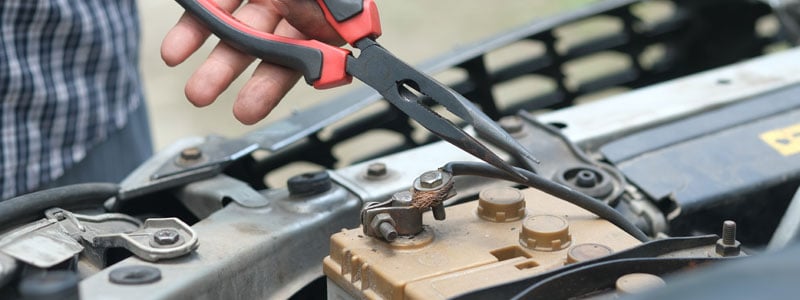Replacing your battery is an essential part of car maintenance. Your owner’s manual will provide specific advice about when to replace your car battery, but it’s generally recommended to change a battery after three years or if a test reveals the battery is weak. An engine that starts slowly or dim headlights can also signal your battery is ready for a change.
Tip: How much does a car battery cost? You can expect to pay around $50 to $120 for a standard car battery and between $90 and $200 for a premium type.
Having your battery changed at your local auto parts store or mechanic garage during a routine inspection or winterization services is the most convenient option. However, there are many reasons your vehicle battery might fail unexpectedly. When your car battery fails, you can jumpstart your car with someone else’s or replace your battery.
Luckily car battery replacement is a job you can do by yourself with the right tools and information on hand. This step-by-step guide is designed to help you understand exactly how to change your car battery by yourself. It includes the tools you’ll need, safety precautions to take, and clear instructions on how to carry out each step of the process. By the end of this article, you’ll feel confident and empowered to safely handle a car battery replacement on your own. So, let’s dive in and learn how to change a car battery!
How to Remove Car Battery
Even if you’ve never looked under the hood of your vehicle, determining how to disconnect a car battery and remove it is relatively easy. Check your owner’s manual to see where your car’s battery is located. It may be under the hood, in the trunk, under the back seat, or under the floorboard. If it’s under the hood, make sure the engine is cool enough to safely work in the area. Wear gloves and safety glasses for protection while working.
Tip: Gather your supplies before you get started. You’ll need a replacement battery, wrench, wire brush, and battery cleaner, or baking soda and water.
Locate the Battery and Identify the Positive and Negative Terminals
Before determining how to remove the car battery, identify the positive and negative posts. The positive post may have a red plastic cover and the attached cable may be red as well. If both posts look the same, search for a “+” symbol stamped on the battery next to the positive post.
Tip: Take a picture with your phone as a reminder of what your connections look like when set up correctly.
Disconnect the Car Battery Terminals
Begin by disconnecting the negative cable using a wrench to loosen the bolt or nut that secures the terminal. Once the bolt is loose, wiggle the connector back and forth as you lift it from the car battery. Repeat the process with the positive cable.

Remove the Car Battery
Your battery will be secured in place with a metal bar over the top or a metal clamp at the base. Loosen any hardware securing the bar or clamp and remove it and set it aside. Now, the battery is ready to be lifted from the car. Take care to always keep a battery upright as you move it to avoid spilling caustic battery acid on your skin, clothing, or other surfaces.
Get a firm grip on the battery (using the carrying strap if there is one) and lift it from the vehicle. Set it aside for proper battery storage and recycling after the task is finished.
How to Install a New Car Battery
Before installing the new battery, clean any debris in the battery tray, and remove corrosion from the terminals. Use a mixture of baking soda and water or a battery cleaner to clean the inside of the connectors with a wire brush. Thoroughly dry all surfaces before putting the new battery in place.
Place the New Battery in the Battery Tray
Position the battery so the positive and negative posts will match up with the cables, and gently set it in the battery tray. Reattach the clamp or holding bar to keep the new battery in place.
Attach the Terminals to the Battery
Remove the plastic caps that cover the battery posts once the battery is securely in place. Apply a thin layer of anti-corrosion grease or apply protective washers to the new terminals. Connect the positive cable to the new battery first. Push the connector firmly onto the terminal, making sure it’s pushed all the way down. Tighten the bolt. Repeat the process with the negative cable. Wiggle the battery to ensure it’s firmly in place. If necessary, tighten the retaining system before closing the hood.
Start Your Car
After closing the hood firmly, you’ve completed your battery change! Your new battery is fully charged and ready to go. Start your car to make sure everything runs smoothly and pat yourself on the back for a job well done.

How to Jumpstart a Car Battery
Learning how to change a car battery is a good way to ensure you change your battery before it dies completely. However, batteries can die unexpectedly due to mechanical issues, extremely cold weather, or human error (like leaving the headlights or interior light on). If you’re stranded without a new battery, jumpstarting your car with another power source will offer a temporary solution. To complete this task, you’ll need to retrieve the jumper cables from your car emergency kit and have another vehicle present with a strong battery.
Position Cars Facing Each Other
Pull the car with the good battery up in front of the one with the dead battery. They should be close enough for the jumper cables to reach without stretching, but the cars shouldn’t touch. Ensure both cars are in park and engage the parking brake for safety.
Attach the Clamp of one end of the red positive cable to the dead battery’s positive terminal
If you’ve never used your jumper cables, take a moment to examine them. The red cables are used to connect to the battery’s positive posts and the black to the negative. Attach the clamp of one end of the red positive cable to the dead battery’s positive terminal first.
Connect the clamp of the other end of the positive terminal of the good battery
Connect the other red clamp located at the other end of the positive terminal to the good battery. Only after the positive cables are firmly connected, move to the negative cables.
Attach one end of the negative black cable to the negative terminal of the good battery
Clamp one end of the black negative cable to the negative terminal of the good battery.
Attach the other end of the negative cable to the engine block of the car with the dead battery
When the first three clamps are in place, it’s time to clamp the final negative cable to bare metal. The engine block of the dead vehicle is the most convenient way to do this.
Start the car with the good battery
Now that everything is connected, you can send power to your dead battery. Have the owner of the vehicle with a good battery start their car. Let the donor vehicle run for 5-10 minutes to charge the dead battery.
Turn the ignition key of the car with the dead battery
After waiting five minutes, you can try starting your car. If your car starts when you turn the ignition, the process is complete. As long as your vehicle is mechanically sound, your battery should keep the car running long enough to get it to a mechanic or auto parts store to have the battery checked.
Disconnect the jumper cables in reverse order
When the car is running, it’s time to disconnect the jumper cables. Always complete this process in reverse order to the way they were connected.
- Remove the negative clamp from the engine block.
- Remove the other negative cable from the donor car’s negative battery post.
- Remove the positive cable from the donor car’s positive battery post.
- Remove the final positive cable from your newly charged battery.

How to Check Your Car Battery
Now that you know how to change a car battery, you can determine if it’s time for a new one. If you can’t recall when you replaced your battery, know it’s at least three years old, or suspect it’s getting weak, it’s a good idea to check your battery. The easiest way to achieve this is by visiting your local auto parts store. Most stores will have a certified technician check your battery for free. If this isn’t an option you can perform a load test or test the battery voltage at home.
Test the Battery Voltage
- Turn off your car’s ignition.
- Set your multimeter to 20VDC
- Place the red lead on the positive battery terminal
- Place the black lead on the negative terminal.
- Read the measurements. If the reading is below 12.4 volts, you may need to recharge or replace your battery.
Perform a Load Test
- Without starting your engine, turn on your headlights and leave them on for 10-15 minutes.
- After the time is up, watch how your headlights behave when you start your car.
- If your headlights dim noticeably as the engine turns over, your battery may need to be charged or replaced.
There are many reasons a car battery can fail. Changing your battery yourself is safe and well worth the effort if it saves you the cost of having your car towed to a mechanic when it dies unexpectedly. Whether you perform your own car maintenance or need to change your battery in an emergency situation, use this handy guide as a reference to complete the task accurately and safely.







